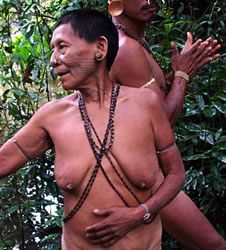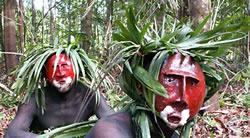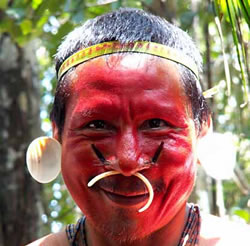THE MATIS
The Matis of Brazil were also contacted by rubber tappers as early as the 1880s when they were forced to labor for them. But it would not be until the 1980s that steady contact with outsiders occurred resulting in mass epidemics, including the common cold, for which they had no biological defenses. As a result, more than half of the Matis population died, a death rate likened to the bubonic plague that ravaged Europe long ago. Also lost was much of the knowledge of elders and the rituals that only they knew how to perform. But one important custom that managed to survive the wake of destruction was tattooing.
During the first decade of successive epidemics in the 1980s, however, the tattooing rituals were halted indefinitely due to a variety of factors. For one, the week-long festivities that accompanied the tattooing ritual were deemed to be inappropriate because it was not proper to celebrate with so many Matis in mourning. The Matis also feared that the ancient tradition might harm young men recovering from their sicknesses because of the ritual's physical demands and spiritual potency.
The "tattooing festival" as it has been called typically occurred during the middle of the rainy season (November to December) when hunting was restricted due to bad weather and the annual corn crop was ready to be harvested. The Matis state that their ancestor spirits (mariwin) come to visit them at this time of the year and that is why it is an appropriate time for male and female initiates to be tattooed. |
 |
The female elder Tupã Matis.
Photograph © Dan James Pantone/www.MATSES.org |
Interestingly, when the corn is planted earlier in the year a special garment is used and a digging stick employed to "pierce" the seeds into the earth. This same outfit is also worn during the tattooing festival, and the action of the planting stick is likened to the pricking of the tattoo needle upon the skin.
|
|
As preparations for the tattooing begin, some of the corn is harvested and fermented to make beer for the ceremonial occasion. Then, a village leader taps the sides of one of the fermenting beer pots and chants a ritual phrase likening it to a swelling river after a heavy rain. This reference to abundance and overflow is directly associated with one of the goals of the tattooing festival: to promote fertility and rapid growth of the children who will be marked. And since corn is the fastest growing plant in the Matis world, it is an appropriate model from which to symbolize the transformation that will soon take place. Of course, as beer matures and ferments it becomes "bitter" (chimu) with age: a process likened to the human lifecycle. |
The French anthropologist Philippe Erikson who has spent many years documenting the culture and traditions of the Matis, describes in more detail the symbolic associations between corn, "bitterness", and the tattooing rite:
The Matis ascribe tremendous value to the concept of chimu, which they contrast with bata, "sweet, salty." This opposition seems to permeate Matis thought: the mature, stout, dark, bitter, or masculine is systematically distinguished from the young, skinny, pale, sweet, or feminine. The Matis also connect chimu with themselves, while they associate bata with outside people (white men, other tribes). In the context of the tattooing festival, this distinction takes precedence over the association of chimu with the masculine.
Corn is offered as a model for children because it grows, hardens, blackens (some varieties have dark grain), and above all becomes chimu in less than four months. Chimu suggests pain, but also power - that of any poison or medicine or of shamans generally. An overdose of bitterness can cause sickness, but the more a person can stand, the greater potential he or she gains. Such powerful substances are generally thought to be transmitted by stinging. In the Matis view, the innumerable needle stings used to create tattoos transmit power. Permanent tribal face marks enhance maturity, they reason, by turning teen-agers chimu (bitter, sturdy).
Young Matis children too young to be tattooed undergo a hardening ritual to stimulate their growth and instill chimu. And during the tattoo festival, a costumed elder in the guise of a mariwin spirit appears and whips the children with a palm frond that holds small thorns to "sting" them.
About the same time, corn beer is flowing freely for everyone in attendance at the festival, and the tattoo neophytes become somewhat dulled by their intoxication as they are tattooed one after another. They are compelled to remain silent and are praised for their courage as a palm thorn tattoo implement is repeatedly pricked into their skin. |
 |
Masked Mariwin Spirits.
Photograph © Dan James Pantone/www.MATSES.org |
The patterns the initiates receive resemble fine lines tattooed on the temples and forehead. And as they grow older, additional lines will come to adorn their cheeks.
The procedure, which is said to be more painful on the forehead and temples, is experienced as a kind of dangerous and bloody test that proves the initiates' value in the eyes of the elders and particularly the mariwin. According to the Matis, tattooing permits one to appear more like the ancestral spirits because it makes your face black which is the color of prestige and of the dead. In turn, those individuals who are tattooed are believed to gain power (chimu) because the ancestors are pleased by those who are marked like them. In this way, tattooed men and women gain control over their destinies because they have satisfied those higher powers (ancestors) who control life and the surrounding world.
Once all of the tattooing is completed, the chimu of the beer and tattooing is transferred to the initiates. The ancestor spirits leave and the newly tattooed are required to follow a set of taboos until their incisions heal. These restrictions include not bathing and observing a prescribed diet while they remain secluded in the communal house where they were tattooed. After their tattoos have scabbed over, the initiates give away all of their belongings and receive equivalent items reserved for men and women. It is at this moment that they begin their new lives as adults in the Matis community. |
 |
Matis Chief Txemã. Photograph © Dan James Pantone/www.MATSES.org |
Next Page | 1
|
2 |
3 |
4 |
5 |
6 |
7 |
8 |
Museum photo gallery of the images
on this page may be seen here. |



